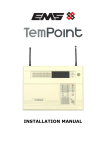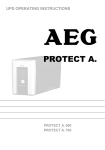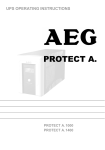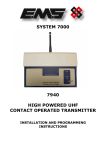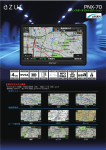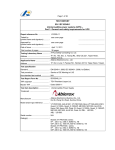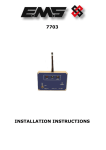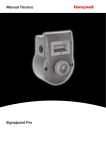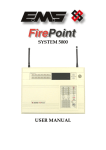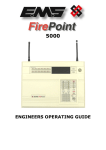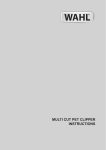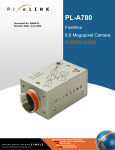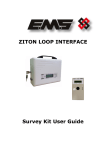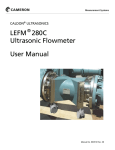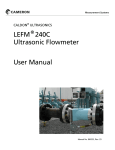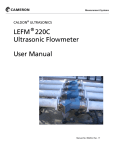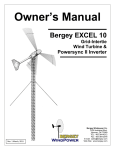Download Installation Guide
Transcript
INSTALLATION GUIDE Table of Contents Section Page No UU1. INTRODUCTION .......................................................................................... 3 2. WARNINGS AND CAUTIONS .............................................................................. 3 3. UNPACKING.................................................................................................... 3 4. INSTALLATION ................................................................................................ 4 5. CONTROL PANEL - REMOVING ITEMS BEFORE MOUNTING..................................... 4 6. MOUNTING THE ENCLOSURE TO A WALL ............................................................ 4 7. REPLACING ITEMS AFTER MOUNTING................................................................. 4 8. MOUNTING DIAGRAMS ..................................................................................... 5 9. POWERING THE SYSTEM .................................................................................. 6 10. EXTERNAL WIRING ........................................................................................ 7 10.1 HARDWIRED SOUNDER ................................................................................... 7 10.2 HARDWIRED CALL POINT ................................................................................. 7 10.3 DEVICE WIRING ........................................................................................... 7 11. INSTALLATION ADVICE................................................................................... 8 12 DEVICE INSTALLATION...................................................................................22 12.1 INPUT/OUTPUT UNITS ...................................................................................22 13. CONTROLLER INFORMATION ..........................................................................23 TSD008 2 SIGNALPOINT INSTALLATION GUIDE, ISSUE 1 – 04/09/13 1. Introduction This manual provides an installation guide to the SignalPoint Fire Control Panel and peripheral devices. It is important that for correct installation, the instructions given in this manual are followed. Should you have any questions regarding the installation of the Signal Point system, please ring our technical Helpline No 08712 710804 (0800-1800 Mon-Fri), or alternatively your regional technical support representative. Whilst this manual provides an overall installation guide, refer to the User Manual for details on how to operate the system. 2. Warnings and Cautions It is very important that the procedures in this installation manual are carefully followed. This will prevent injury. The user of this manual should be a suitably trained installer and should be familiar with all of the relevant regulations. When installing the system, it is important to use the correct fixings, which are suitable for the type of surface being secured to. SignalPoint includes components, susceptible to damage from Electro Static Discharge (ESD). These components can be permanently damaged through routine handling, if precautions are not observed. Where handling is unavoidable, adequate earthing precautions should be taken. E.g. an earthed wrist strap. Minimise the handling of static sensitive PCB devices. Also always transport “loose” PCB’s in containers, manufactured with ESD protective properties. Also avoid placing static sensitive devices on plastic surfaces. 3. Unpacking SignalPoint control panels are simple to install, provided that the recommended procedures in this manual are followed. Refer to the Engineers Operating Guide for details on the programming of system operation, and the User Manual for the overall system operation. Care should be taken when handling. Dropping any of the parts onto hard surfaces may cause damage to the case and internal circuitry. Products should be kept in their packaging until installation. This minimises any risk of damage. Retain all packaging until the installation activities have been completed. Any products surplus to requirements, or requiring returning to EMS, should be returned in the original packaging. CONTROL PANELS ARE SUPPLIED WITH ALL DETECTOR ZONES IN TEST. PLEASE REFER TO THE ENGINEERS OPERATING GUIDE TO MAKE ACTIVE. TSD008 3 SIGNALPOINT INSTALLATION GUIDE, ISSUE 1 – 04/09/13 4. Installation Following the Site Survey, System Control Panels should be positioned as stated considering:The recommended minimum distance between metal objects or equipment for the aerial is 400mm. The recommended minimum distance to any electrical equipment is 2 metres, (See Figure 1). 5. Control Panel - Removing Items before Mounting Before mounting the unit, it is necessary that certain items be removed, so as to prevent the risk of damage to the internal circuitry. Remove the Door Assembly from the Back Box. To achieve this, disconnect the Ribbon Cables and Earth links, loosen the hinge screws on the Back Box side of the hinge and pull the door away. Ensure that the Door Assembly is suitably stored and that ESD precautions are observed (see Figure 2). Establish the required cable entries. Knockouts should be made prior to fixing the Back Box to the wall. Ensure that the Back Box is free of swarf and other debris. 6. Mounting the Enclosure to a Wall It is recommended that the Control Panel be mounted in accordance with the site survey so that the display is at eye level. Achieve this firstly by securing it to the wall, via the single fixing “keyhole”, located in the top centre of the box. The box should be hung and levelled, allowing holes to be marked out for each of the four remaining mounting holes (shown on figure 3). Once the Back Box is fitted to the wall, all external cabling should be run to the box, including the provision of an unswitched 240 volt supply. The mains cable should be dressed away from the main radio PCB and should be as short as possible. 7. Replacing Items after Mounting Replace the Door assembly by reversing the steps given in Section 5, ensuring that all electrical connections, including the earth leads, are made. Ensure that both UHF and VHF aerials are fitted to the top of the Control Panel. To ensure correct fitment, the aerial identified with the coloured band must be fitted to the connector identified with the coloured band. If high gain aerials are to be used they must be positioned in accordance with the site survey. TSD008 4 SIGNALPOINT INSTALLATION GUIDE, ISSUE 1 – 04/09/13 8. Mounting Diagrams Figure 1 Figure 2 TSD008 5 SIGNALPOINT INSTALLATION GUIDE, ISSUE 1 – 04/09/13 Figure 3 9. Powering the System The SignalPoint Control Panel has an internal 3 amp power supply and charger as standard. On larger systems and where hard-wired sounder circuits are used, it may be necessary to provide an additional power supply or increase the size of the system power supply and charger. When using an additional power supply, it should be mounted in an appropriate cabinet adjacent to the control panel. Should this be impractical, the maximum distance between the Control Panel and power supply/charger should not exceed 3 metres. Ensure that the voltage drop between the supply and the main panel does not exceed 0.5v. The 240V power supply to the Control Panel must be made by way of an individual fused spur, situated adjacent to the Control Panel. The fused spur must have it’s own power supply circuit fitted with a 3 Amp fuse. Affix a red circuit breaker, labelled “Fire Alarm, Do Not Switch Off”, to the circuit. It is recommended that the circuit breaker be secured from unauthorised access. The fused spur should be similarly labelled as “Fire Alarm”. When powering up, the following procedure must be followed. If the panel is switched off, apply the mains power to the unit and connect the batteries (observing the correct polarity). After the system has completed its initialisation sequence, the display will show, Figure 4 followed by Figure 5 Warm Start Searching . . . . . . . . . . FIRIS OS V1.6 01 02 03 04 05 06 Figure 4 TSD008 Figure 5 6 SIGNALPOINT INSTALLATION GUIDE, ISSUE 1 – 04/09/13 When the Control Panel is first powered up, the “General Fault” LED will illuminate and the fault buzzer will sound. This continues whilst the system initialises itself and runs through self-test routines. Once initialised, the green “Power” LED will illuminate. At this time the “General Fault” LED will also be illuminated, whilst the display will indicate a “PR” fault. Press “SILENCE ALARM” followed by “RESET” to clear this LED. The Control Panel will run through a series of diagnostic self tests. The illumination of the applicable LED and the sounding of the fault buzzer will indicate any errors on the display. Under normal non fault conditions, the display will indicate status as “Normal” (see Figure 6). If the Key Switch is left in the “On” position, the display will indicate that the panel is in “Access mode” (see Figure 7). EMS FIRE SYSTEMS LTD Status Normal DATE EMS FIRE SYSTEMS LTD Panel in Access TIME 0 FOR ACCESS Figure 6 TIME Figure 7 10. External Wiring 10.1 Hardwired Sounder The SignalPoint Control Panel includes provision for two hardwired sounder circuits. The circuitry monitors two pairs of conductors fitted with 4k7 End of Line resistors. No connection to the control Panel should be made at this stage. The maximum current permitted is 250mA per circuit. 10.2 Hardwired Call Point The SignalPoint Control Panel includes provision for a hardwired Call Point interface. The Control Panel monitors this input via a 4k7 End of Line resistor. No connection to the Control Panel should be made at this stage. Note: The external connections & wiring must be tested in the conventional manner. Under no circumstances should the system circuitry be tested using a meggar tester, once the connections to the control panel, or peripherals, has been made. 10.3 Device Wiring Using an Ohmmeter, check both sounder circuits to ensure that they have a 4.7k ohm resistance across the connections and that the resistance between each connection and the Control Panel earth point is greater than 20 M Ohm. Check any Call Point external wiring. The resistance across the Call Point connection should read 4.7k. Ensure that the resistance between each connection and the Control Panel earth point is greater than 20 M Ohm. Once external wiring circuits have been checked, make the connections to the control panel. The Control Panel should be powered down prior to termination. Connect all external wiring to the applicable Control Panel terminals (see drawing p02910). Upon completion of this, re-power the Control Panel. TSD008 7 SIGNALPOINT INSTALLATION GUIDE, ISSUE 1 – 04/09/13 11. Installation Advice. Ensure that you have all equipment required to complete the system installation. Ensure that the correct fixings and fasteners are used for all installation work. Observe ESD precautions. Familiarise yourself with the system details and layout, before commencing any installation activity. Any anomalies must be addressed with the Surveyor, End user or the equipment supplier. Ensure that the Control Panel back box is clean and free of swarf prior to fitting the internal assemblies. Also ensure that aerials are fitted with anti tamper cones before applying 230V to the control panel. The 240V power supply to the Control Panel must be made by way of an individual fused spur, situated adjacent to the Control Panel. The fused spur must have it’s own power supply circuit fitted with a 3 Amp fuse. Affix a red circuit breaker, labelled “Fire Alarm, Do Not Switch Off”, to the circuit. It is recommended that the circuit breaker be secured from unauthorised access. The fused spur should be similarly labelled as “Fire Alarm”. Wherever practical, fix detectors so that the red LED faces the main entrance to the room. Should it be necessary to remove the two aerials fitted to the Control Panel, ensure that when refitted, the coloured band on the aerial corresponds with the coloured disk on the BNC connector on the panel. Ensure that the 240V AC mains supply is fused and unswitched. TSD008 8 SIGNALPOINT INSTALLATION GUIDE, ISSUE 1 – 04/09/13 TSD008 9 SIGNALPOINT INSTALLATION GUIDE, ISSUE 1 – 04/09/13 TSD008 10 SIGNALPOINT INSTALLATION GUIDE, ISSUE 1 – 04/09/13 TSD008 11 SIGNALPOINT INSTALLATION GUIDE, ISSUE 1 – 04/09/13 TSD008 12 SIGNALPOINT INSTALLATION GUIDE, ISSUE 1 – 04/09/13 TSD008 13 SIGNALPOINT INSTALLATION GUIDE, ISSUE 1 – 04/09/13 TSD008 14 SIGNALPOINT INSTALLATION GUIDE, ISSUE 1 – 04/09/13 TSD008 15 SIGNALPOINT INSTALLATION GUIDE, ISSUE 1 – 04/09/13 TSD008 16 SIGNALPOINT INSTALLATION GUIDE, ISSUE 1 – 04/09/13 TSD008 17 SIGNALPOINT INSTALLATION GUIDE, ISSUE 1 – 04/09/13 TSD008 18 SIGNALPOINT INSTALLATION GUIDE, ISSUE 1 – 04/09/13 TSD008 19 SIGNALPOINT INSTALLATION GUIDE, ISSUE 1 – 04/09/13 TSD008 20 SIGNALPOINT INSTALLATION GUIDE, ISSUE 1 – 04/09/13 TSD008 21 SIGNALPOINT INSTALLATION GUIDE, ISSUE 1 – 04/09/13 12 Device Installation 12.1 Input/Output Units Ensure that all I/O Units are sited in accordance with the survey and design details. Remove the two lid retaining screws situated on the front cover. The front section of the unit can now be removed exposing the inside of the device. See Figure 4. Figure 4 Offer the unit up to the wall and using the back plate as a template mark out the four fixing holes. The unit can be fixed to the wall and all external wiring connections made. When all connections have been made to the unit the lid can be re-fixed. TSD008 22 SIGNALPOINT INSTALLATION GUIDE, ISSUE 1 – 04/09/13 12.2 Half Watt Transmitters Ensure that all Half Watt Transmitters are sited in accordance with the survey and design details. Remove of the four lid retaining screws situated on the front cover. The front section of the unit can now be removed exposing the inside of the device. See Figure 5. Ensure that all Half Watt Transmitters are sited in accordance with the survey and design details. Remove of the four lid retaining screws situated on the front cover. The front section of the unit can now be removed exposing the inside of the device. See Figure 5. Figure 5 Offer the unit up to the wall and using the back plate as a template mark out the four fixing holes. The unit can be fixed to the wall and all external wiring connections made. When all connections have been made to the unit the lid can be re-fixed. TSD008 23 SIGNALPOINT INSTALLATION GUIDE, ISSUE 1 – 04/09/13 13. Controller Information TECHNICAL INFORMATION FOR THE SIGNALPOINT CONTROLLER Dimensions: Operating Frequencies: Operating Temperature: Humidity: Channel Spacing: Output Transmitter Power: Supply: Current Consumption: Operating Voltages: Battery space: Inputs: Outputs: Recommended battery replacement intervals: TSD008 330mm x 450mm x 116mm VHF – 173.2 MHz – 173.5MHz (receiver) UHF – 458.5 MHz – 459.5 MHz (transmitter) -10 to 55 degrees C Up to 75% non-Condensing. 25 kHz 0.75W (500 mW) (+ 27DBH) 240v 50 Hz 260mA in standby 24v DC nominal 2 x 12volt 9Ah batteries (not supplied) EMS only recommend: Panasonic Model No: UP-RW1245P1 or a battery of equivalent specification 1 x 27v DC 2 x 0.25amp 24v DC sounder outputs 2 x auxiliary fire relays 2 x auxiliary fault relays 1 x RS 485 serial port 1 x RS 232 serial port Standby 9Ah batteries – 2 years Lithium clock and RAM batteries – 5 years (Re-order no – 5-5812) 24 SIGNALPOINT INSTALLATION GUIDE, ISSUE 1 – 04/09/13 TSD008 25 SIGNAL POINT INSTALLATION GUIDE, ISSUE 1 – 04/09/13 Dealer Information: EMS Group Head Office Technology House, Sea Street Herne Bay, Kent CT6 8JZ England Tel: +44 (0) 8712 710804 Fax: +44 (0) 1227 369679 Email: [email protected] The information contained within this literature is correct at time of publishing. The EMS Group reserves the right to change any information regarding products as part of its continual development enhancing new technology and reliability. The EMS Group advises that any product literature issue numbers are checked with its head office prior to any formal specifications being written. www.emsgroup.co.uk TSD008 26 SIGNAL POINT INSTALLATION GUIDE, ISSUE 1 – 04/09/13



























